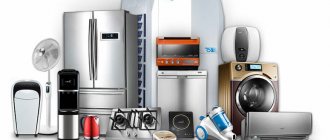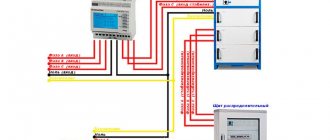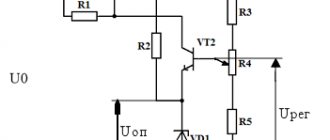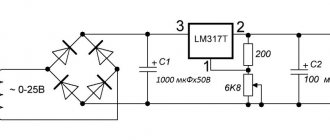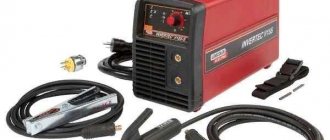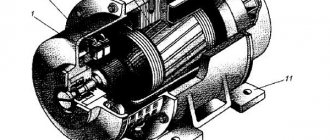The technical characteristics of various types of stabilizers, as well as the recommended scope of application, will help you make the right choice.
What types of stabilizers are there and what are their differences?
An AC voltage stabilizer is a converting device that adjusts the voltage coming from the network and brings it to the nominal value (220/230 V for single-phase and 380/400 V for three-phase networks), which is maintained in continuous mode and supplied to the connected electrical appliances.
Currently, there are several types of voltage stabilizers on the Russian power supply market, namely: relay, electromechanical, electronic and inverter models. Depending on the type, they are capable of leveling out network surges, sags and overvoltages in certain ranges with varying speeds and accuracy, filtering network interference and protecting the load from short-term power outages.
Let us examine in detail the main differences between the most common voltage stabilizers on the domestic market.
Characteristics and features of relay stabilizers
These devices use transformer technology for correcting the mains voltage.
The devices include an autotransformer, a power relay unit and an electronic control board. The process of voltage stabilization in relay models is performed as follows: the device’s control board continuously analyzes the value of the input signal coming from the network and, if a voltage surge or sag occurs, the stabilizer power relay switches the required segment of the transformer winding so that the input voltage acquires a nominal value.
Since the voltage regulation in these products occurs in steps, their response to changes in network parameters occurs with some delay, which can reach up to 10-20 ms. Due to insufficient speed, such stabilizers cannot provide high-quality protection against sudden increases in voltage or voltage drops. Frequent surges that occur in the electrical network reduce the quality of operation of the power relay and significantly accelerate its wear.
The accuracy of the output voltage for relay models depends on the number of adjustment stages and their speed. As a rule, their output signal error can reach up to 10% of the nominal value, which is not suitable for electrically sensitive devices. In addition, due to the discreteness of stabilization, micro-discontinuities occur in the power supply and distortion of the output signal shape.
Due to the fact that the circuit of relay models does not contain electronic components that can be heated or suffer from condensation, the devices do not require special cooling and are able to operate at sub-zero ambient temperatures reaching -20° C.
It is also important to note that the relays in stabilizers make characteristic clicks during operation, which is why the devices are usually installed in non-residential premises.
The main advantages and disadvantages of relay stabilizers are shown in the table below:
| Flaws | Advantages |
|
|
Relay stabilizers are mainly chosen to protect loads that do not require power quality (for example, kitchen appliances, lighting systems, television equipment and some power tools) in relatively stable power networks. The devices can be installed in separate technical rooms that do not have heating.
Regulation time
The voltage regulation time, also known as the stabilization speed, is another most important indicator, and here the situation is completely different.
So the relay stabilizer reacts to changes in the incoming voltage at a speed of 10 milliseconds, and it does not matter how much it has dropped or increased (within its operating range of 140-260V), it will change mode in these fractions of a second and will produce a voltage of 200+/ - 8%.
At the same time, the electromechanical stabilizer has a stabilization speed of only 10 Volts per second. So, if the voltage drop is 30 volts (input voltage is 190V), the servo model will take about 3 seconds to output 200+/- 2%. During all these 3 seconds, devices connected to the stabilizer will operate at reduced voltage.
In terms of regulation time, a relay stabilizer is significantly superior to an electromechanical one.
Characteristics and features of electronic stabilizers
According to the scheme of their operation, these devices are similar to relay types, only in their composition instead of power relays they have electronic switches - triacs or thyristors.
The voltage correction process in electronic models is controlled by a microprocessor, which, when a deviation in network parameters is detected, activates a power switch that switches the necessary transformer winding to obtain an output voltage as close as possible to the rated value.
Electronic keys are smaller in size compared to power relays, so such stabilizers are more compact in size. In addition, the operating circuit of electronic models does not contain any moving elements, so they are considered more reliable and produce less noise during operation compared to relay types.
Electronic stabilizers, like relay models, are characterized by discrete (stepwise) voltage correction. Although it may be smoother and less severe, it may still cause interference with some electrically sensitive loads.
A large number of transformer windings and a high switching speed (operation speed averages 10 ms) allows electronic models to cope with sudden voltage surges and adjust the input signal with higher accuracy compared to relay-type devices. On average, the input voltage range in such models is 130-270 V, and the output signal error is 5%. However, the devices are not able to cope with significant network sags, and the accuracy of input signal stabilization may not be enough for consumers that are particularly sensitive to voltage quality, for example, computer equipment.
Another important disadvantage of electronic devices is the non-sinusoidal shape of the output voltage (trapezoidal or rectangular, depending on the model), which can be caused by the operation of power switches - triacs/thyristors. This feature of operation imposes restrictions on the use of these devices for certain types of loads. In addition, some electronic models have a small overload capacity, which can be as low as 40%. Frequent and significant overloads in such devices can lead to early failure of power switches.
The main advantages and disadvantages of electronic stabilizers are given in the following table:
| Flaws | Advantages |
|
|
Electronic models have higher technical characteristics compared to relay types, which allows them to be used in electrical networks where sudden and significant voltage drops occur. However, they are not suitable for loads with electric motors, since a distorted voltage waveform can negatively affect the operation of such a load. It is also not recommended to use this type of stabilizer with professional audio and video equipment due to interference created during the switching of transformer windings, which can spoil the quality of sound or image.
TOP 3 relay devices up to 1 kW
This includes the cheapest and simplest models, characterized by maintainability and reliable operation. Another feature is that a characteristic clicking sound is produced during operation.
No3. Quattro Elementi Stabilia 1000
An Italian-made device that can cope with the most serious power surges in domestic conditions - from 140 V to 270 V. There are, of course, models with much higher power, but this device is still very popular in Russia. As a rule, they buy it for computer equipment. The efficiency of the model is quite high – it reaches 98 percent. Provides protection against power surges, overheating, and damage due to short circuits. The model is inexpensive, compact, weighs only 2.7 kg.
pros
- 3-stage protection;
- excellent efficiency;
- low cost;
- compactness, light weight.
Minuses
- power restrictions.
Prices for Quattro Elementi Stabilia 1000
Quattro Elementi Stabilia 1000
Video - Review of Quattro Elementi Stabilia 1000
No2. Wester STB-1000
Compact floor-standing device, characterized by quiet operation and ease of use. Works with a wide voltage range - 140-260 V (the device has an error of 8 percent). Reliable protection of household appliances from power surges, overheating and short circuits is provided. There is a digital display that displays all the necessary information. Air cooling. It is permissible to use the device at temperatures from 0 to +40 degrees. The model operates silently and provides good stabilization. But it costs even more than the leader of this rating.
pros
- noiselessness;
- excellent voltage stabilization;
- short circuit protection;
- no heating during operation.
Minuses
- The light blinks and clicks when the relay is activated.
Reviews and prices for Wester STB-1000
No1. RESANTA LUX ASN-1000N/1-C
The leader of our rating is a popular model, characterized by good active power (1 kW) and an extremely simple design. This Latvian stabilizer operates with voltage within 140-260 V, and provides protection against interference and overheating. The error is small (also 8 percent), and it does not confuse buyers who most often purchase this device for household use.
pros
- high-quality stabilization of voltage drops;
- high build quality;
- affordable price;
- presence of 2 sockets;
- reliability.
Minuses
- There may be a plastic smell at first.
Prices for RESANTA LUX ASN-1000N/1-C
RESANTA LUX ASN-1000N/1-C
Characteristics and features of inverter stabilizers
Inverter stabilizers are devices of a new generation due to a completely different operating principle compared to other types.
They are based on double energy conversion technology or Instant Reaction & Double Conversion (IRDC), which involves an instant reaction and double conversion. In the operating circuit of inverter models there is no automatic transformer and switching elements, but instead there are elements such as a rectifier, capacitor, inverter and microcontroller.
During operation of inverter devices, the input unstable voltage is first rectified and accumulated in a capacitor, and then, using an inverter, it is converted back into alternating voltage, but with reference characteristics. As a result, the load is continuously supplied with a signal of high accuracy (±2%) and an ideal sinusoidal shape, regardless of the network parameters. Due to this principle of operation, inverter models are able to instantly respond to surges and sags in the mains voltage in a fairly wide range, which is 90-310 V.
Thanks to the presence of a capacitor that stores electricity, inverter models provide reliable load protection from significant and sudden changes in electricity, as well as short-term power outages (up to 0.2 s). Since inverter models do not have mechanical moving elements, they do not produce unpleasant sounds during operation. However, in some models, usually with an output power of more than 1 kVA, there may be a slight noise from the cooling system, comparable to the operation of coolers on a personal computer or laptop.
Inverter stabilizers have the largest number of electronic protections compared to relay and triac/thyristor devices. They are capable of automatically recovering from network failures (when the voltage goes beyond the operating range of the stabilizer), short circuit, output overload, overheating and malfunctions. In addition, built-in network filters and a varistor provide protection against surge voltages and high-frequency interference.
Inverter models are able to work effectively with many gasoline and diesel generators, adjusting not only the voltage value, but also its shape. High overload capacity (up to 150%) allows the devices to cope with inrush currents of equipment that contains electric motors.
Almost all models have an automatic bypass, which ensures uninterrupted operation of the load in cases where the stabilizer malfunctions or is damaged.
The only significant drawback inherent in inverter models is their high price. But this is explained by the fact that these devices have much greater functionality and capabilities compared to other types of stabilizers. The main advantages and disadvantages of inverter stabilizers are shown in the comparative table below:
| Flaws | Advantages |
|
|
Due to their high technical characteristics and wide functionality, inverter models are actively used not only in everyday life, but also in commercial and industrial areas. They are able to provide reliable protection from unstable voltage for the most electrically sensitive devices, which include heating systems, pumping equipment, refrigeration units, video surveillance systems, multimedia equipment, computer devices, etc.
TOP 3 relay devices up to 5 kW
Such devices are used to protect PCs, refrigerators, etc. Let's get acquainted with the most successful models.
No3. RESANTA ACH-5000/1-C
A powerful Latvian-made device that stabilizes voltage in the range of 140-260 V. We also note that the model is a floor-standing type, capable of operating with a current frequency of up to 60 Hz. Excellent protection against voltage surges, various interferences and short circuits. With an 8 percent error, it responds in just 7 ms. Cooling is natural. The device weighs 13 kg.
pros
- high build quality;
- fairly low cost;
- great power.
Minuses
- At first there is a plastic smell;
- The handles are quite small.
Prices for RESANTA ACH-5000/1-C
RESANTA ACH-5000/1-C
No2. RUCELF SRWII-6000-L
The peculiarity of this effective wall-mounted device is its high efficiency (equal to 98 percent), wide operating range (from 95 V to 280 V) and, of course, very accurate stabilization. The model is equipped with a microprocessor that controls all work; a wide display allows you to track all readings. Cooling is natural. The device operates quickly enough, does not click loudly, and looks quite attractive.
pros
- works quietly;
- excellent power;
- wide operating range;
- wide display.
Minuses
- quite high cost.
Reviews and prices for RUCELF SRWII-6000-L
No1. Wester STB-5000
This model is considered the most reliable and has the longest service life in its category. The power, of course, is not a record (4 kW to be specific), but the device is able to cope with changes from 140 V to 260 V for quite a long time. Forced cooling reliably protects against overheating. Light weight (only 10.7 kg), compact dimensions. The model is easy to use, all characteristics correspond to the declared ones.
pros
- low noise performance;
- high build quality;
- forced cooling system;
- ease.
Minuses
- If the temperature drops below zero, the device's performance deteriorates.
Prices for Wester STB-5000
Single-phase voltage stabilizer Wester STB-5000 (4 kW)
Comparison of the main characteristics of different types of stabilizers
A comparison of the main technical characteristics of relay, electronic and inverter stabilizers is given in the table:
| Stabilizer type | Type of regulation | Reaction time, ms | Input voltage range, V | Output voltage stabilization accuracy, % | Network distortion correction | Input power factor correction | Autonomous load power supply, ms |
| Inverter | continuous | 0 | 90-310 | 2 | There is | There is | 200 |
| Relay | discrete | up to 20 | 160-260 | from 5 to 10 | No | No | — |
| Electronic | discrete | 5-20 | 130-270 | from 5 to 10 | No | No | — |
Note!
The technical characteristics of some voltage stabilizer models may differ from the values given in the above table.
Model range of inverter stabilizers "Stil"
The largest Russian manufacturer of power supply systems, Shtil, produces a wide range of single-phase and three-phase inverter stabilizers with output power from 0.35 to 20 kVA, including:
- single-phase wall and floor/rack mounted models with output power from 0.35 to 20 kVA;
- three-phase floor-standing/rack-mount models with output power from 6 to 20 kVA;
- 3-in-1 configuration models of floor-standing/rack-mount design with output power from 6 to 20 kVA (designed to protect single-phase loads in a three-phase electrical network).
The main technical characteristics of inverter stabilizers produced by Shtil are given in the following table:
| Specifications | Indicators |
| Performance | instantaneous (0 ms) |
| Limit input voltage range | 90-310 V |
| Stabilization accuracy | ±2% |
| Output voltage form | pure sine wave |
| Protection against short-term network loss | yes (0.2 s) |
| High Frequency Interference Protection | yes (range 100 kHz – 30 MHz) |
| Surge protection | yes (built-in varistor 2 kV, 1/50 μs) |
| Other types of protection | from output overloads, internal overheating, short circuit, network accidents, malfunctions |
| Automatic bypass | yes (in models from 0.8 kVA) |
TOP-2 relay devices for 12 kW
Such stabilizers are characterized by the fact that they are used not only in private homes, but also in workshops and office spaces. Let's look at the best models, according to experts.
No2. Wester STB-10000
A high-quality device that operates very quietly. Not the most “sophisticated” and powerful, but still took its place in the ranking (mainly thanks to numerous reviews). With an active power of only 8 kW, the device has such advantages as low weight (17.6 kg) and compactness. For the average home - an ideal option. The display is large and informative; users also note the high-quality cooling system.
pros
- high build quality;
- compactness, light weight;
- very informative screen;
- high-quality cooling system.
Minuses
- power is not the highest.
Reviews and prices for Wester STB-10000
No1. RUCELF SRFII-12000-L
The advantages of this model are high accuracy (in this case the error is only 3.5 percent) and excellent power (10 kW). Can be used for stabilization in single-phase networks. Floor-standing design, with forced cooling. The wires are connected using terminals; it is possible to connect equipment that does not require stabilization. The informative LCD display shows all the necessary information about voltage and errors that have occurred during operation.
pros
- Ease of use;
- good power;
- stabilization accuracy;
- informative liquid crystal display.
Minuses
- The device is quite noisy.
Prices for RUCELF SRF II-12000-L
RUCELF SRF II-12000-L
Where to buy inverter stabilizers "Shtil"?
You can buy models of inverter stabilizers in the official online store. The site provides comprehensive information on each device, including their technical characteristics, functionality, areas of application and user reviews about their practical use in various conditions.
If necessary, you can always seek help in selecting equipment from the company’s specialists. Consultations on the selection, installation and operation of stabilizers are provided via online chat, email and telephone. In addition, the site publishes topical articles prepared by the company’s engineers, which will also help customers choose the right device.
The products presented in the online store are always in stock and available for order by both individuals and legal entities. Buyers enjoy fast delivery to any city in Russia. When ordering, you can choose a convenient payment method and apply for a loan to purchase the necessary equipment.
